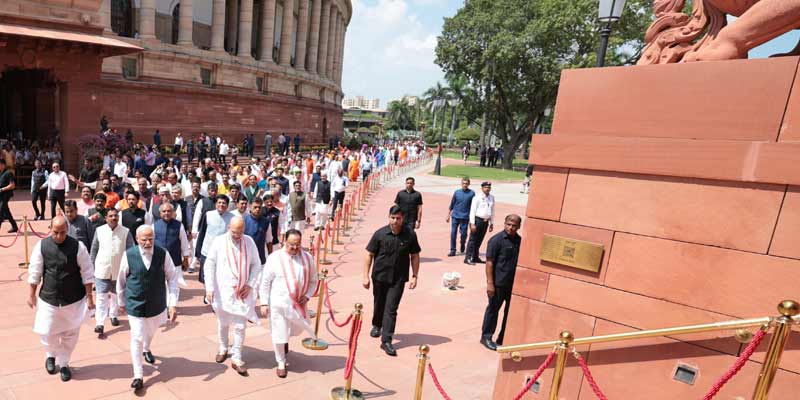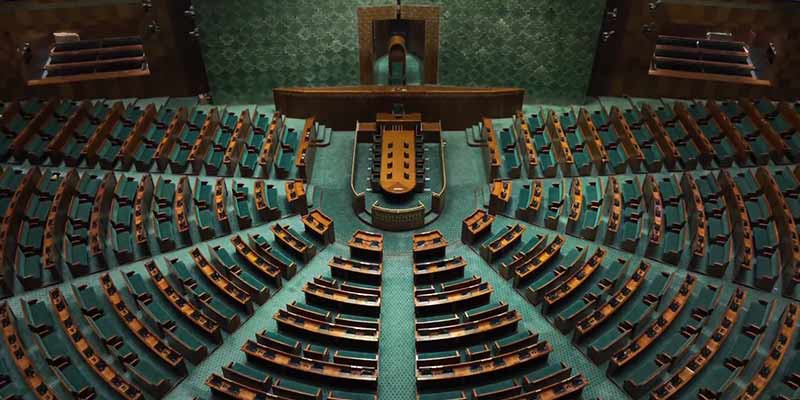- India
- Sep 20
Parliament moves into its new home
• In a historic transition, the Parliament moved into a new complex on September 19.
• The members of the Lok Sabha and Rajya Sabha gathered at the historic Central Hall of the old Parliament building for a function to commemorate the rich legacy of Parliament.
• Later, Prime Minister Narendra Modi led a procession of parliamentarians towards the new Parliament building.
• The procession marked the historic switch over from the iconic circular building to the lion-capitol-topped triangular edifice on Central Vista as the home of India’s democracy.
• The Lok Sabha and the Rajya Sabha met for the first time in the new home on the second day of the five-day special session.
• The old Parliament building will now be known as ‘Samvidhan Sadan’.
Some facts on the old Parliament building:
• The old Parliament building was witness to historic and epoch-changing events — be it revolutionaries Bhagat Singh and Batukeshwar Dutt throwing bombs to “wake up” the colonial rulers, the meeting of the Constituent Assembly or the country’s first Prime Minister Jawaharlal Nehru making his famous “tryst with destiny” speech on the midnight of August 14-15, 1947.
• The old building is a British-era building, designed by Edwin Lutyens and Herbert Baker who were responsible for planning and construction of New Delhi.
• The foundation stone of the old Parliament House was laid on February 12, 1921, and the construction took six years. The opening ceremony was performed on January 18, 1927, by the then Governor-General of India, Lord Irwin.
• The building has been witness to historic debates, momentous legislations and the growth of India’s vibrant democracy. It also braved the 2001 attack by terrorists of the Lashkar-e-Taiba (LeT) and the Jaish-e-Mohammed (JeM), in which nine people were killed inside the Parliament complex.
• The old Parliament House building is a massive circular edifice 560 feet in diameter and the open verandah on the first floor is fringed with a colonnade of 144 creamy sandstone columns, each of 27 feet.
• The focus of the building is the big circular edifice of the Central Hall. On the three axes radiating from this centre are placed the three Chambers for Lok Sabha (House of the People), Rajya Sabha (Council of States) and the erstwhile Library Hall (formerly the Chamber of Princes) and between them lie the garden courts.
• The Supreme Court of India also functioned from the erstwhile Chamber of Princes after it was inaugurated on January 28, 1950, till it moved to the present building in 1958.
• The Central Hall is a place of great historical significance as the transfer of power on the midnight of August 14-15 from British to Indian hands took place in this hall.
• The Indian Constitution was also framed in the Central Hall. The Constituent Assembly met there from December 9, 1946, to January 24, 1950.
Highlights of the new building:
• Prime Minister Narendra Modi inaugurated the new Parliament building in New Delhi on May 28.
• The triangular-shaped four-storey building has a built-up area of 64,500 square metres.
• Its interiors have three national symbols as their main themes — Lotus, Peacock and Banyan Tree.
• The new Parliament building can comfortably seat 888 members in the Lok Sabha chamber and 300 in the Rajya Sabha chamber.
• Inspired by India’s national bird peacock, the Lok Sabha chamber’s basic colour scheme is green. The chamber is three times bigger than the old chamber.
• The design of Rajya Sabha chamber is based on the lotus, the national flower. The colour scheme is red, with carpet and seat cushions of this colour.
• In case of a joint sitting of both the Houses, a total of 1,280 members can be accommodated in the Lok Sabha chamber.
• The building has three main gates — Gyan Dwar, Shakti Dwar, and Karma Dwar.
• The central courtyard has a banyan tree, the national tree.
Manorama Yearbook app is now available on Google Play Store and iOS App Store



